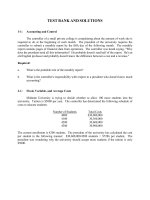Quantitative analysis for decision making an immersive virtual reality learning experience
Bạn đang xem bản rút gọn của tài liệu. Xem và tải ngay bản đầy đủ của tài liệu tại đây (78.89 KB, 4 trang )
www.VLCglobal.com/support
VLC Course Descriptions
Quantitative Analysis for Decision Making
Quantitative Analysis for Decision Making
An Immersive Virtual Reality Learning Experience
2011-2012
Course Description
This course provides the student with the concepts, methods and tools for the application of logical and
quantitative analysis to business decision making and problem solving. It familiarizes the student with a
wide range of software and other classical and contemporary resources related to decision and problem
analysis, including basics of logic and decision making, principles of optimization, probabilistic
distributions, linear programming, simplex, queuing and transportation problems, break even analysis,
inventory management, forecasting and simulation. The course highlights the benefits as well as the limits
of quantitative analysis in a real-world context. This course may be adapted for the graduate and
undergraduate levels.
Materials
Readings, assignments, problems and assessments are integrated into the courseware. Any additional
materials will be assigned by the instructor at the start or during the course.
Course Outline & Assignments
Assignments will change from time to time as new resources become available, contemporary events have
bearing on the topics, or the social, legal, or economic environments change.
FUNDAMENTALS OF DECISION MAKING AND PROBLEM SOLVING (Module One, 4-6 hours)
•
•
•
•
•
•
•
•
•
•
•
•
•
•
Words of the Wise
What is a Decision? What does it mean to solve a problem?
Understanding Limitations - every problem does not have a solution
What is a Good/Bad Decision?
Why Process is Important
Laziness
Predictably Irrational - Self Deception
The wrong people doing the analysis, making the decision
No or Poor Objectives
Faulty Decision Criteria
Weak, Irrelevant Assumptions
Selective Perceptions & Data Contamination
Foregone Conclusions
Readings and Resources
FUNDAMENTALS OF LOGICAL PROCESSES (Module Two, 4-6 hours)
•
•
•
•
•
Examples of Logical Fallacies
The Limits of Probabilities Built on Past Experience
Inductive, Deductive Reasoning
The Role of Creative Thinking in Decision and Problem Solving
Tautologies
HOW QUANTITATIVE METHODS CAN HELP WITH DECISIONS AND PROBLEMS
(Module Three, 4-6 hours)
1
VLC Course Descriptions
•
•
•
•
•
•
•
•
•
www.VLCglobal.com/support
Quantitative Analysis for Decision Making
Comparing Quantitative and Other Approaches
Practical Limits on Quantitative Analyses
Principles of Optimization
Introduction to Optimization Software
Statistics & Probabilities
Readings and Resources
Basics of Optimization and Linear Programming
Break Even Analysis
Product Mix
DECISION ANALYSIS PRINCIPLES AND METHODS (Module Four, 4-6 hours)
•
•
•
•
•
•
•
•
•
•
•
•
Recognizing the Expertise of the User Limits Effectiveness
Spreadsheets & Data Bases
Linear Programming & Simplex
Decision Analysis
Decision Trees and Implications
Probabilistic Statistics and Decision Making
Probability Definitions
Distributions
Correlation
Probability & Tests of Significance
False Positives
Flaw of Averages
OPTIMIZATION APPLIED TO TYPICAL BUSINESS DECISIONS (Module Five, 4-6 hours)
• Reducing bias in qualitative analysis
• Applications of linear programming that have been encountered in practice
• An appreciation for the problems that can be modeled as linear programs
• Practice and experience in formulating realistic linear programming models
• Make or buy decisions
• Production scheduling decisions
• Work force allocation decisions
MARKETING AND FINANCIAL DECISIONS (Module Six, 6-8 hours)
•
•
•
•
•
Basic and feasible solutions to systems of linear equations
Simplex method for solving linear programming problems
Marketing decisions
Financial decisions
Operations decisions
DISTRIBUTION AND NETWORK DECISIONS (Module Seven, 6-8 hours)
•
•
•
•
•
•
•
Special features of transportation, assignment and transshipment problems
Network and linear programming models of the transportation, assignment and transshipment
problems
The shortest route problem
The maximal flow problem
The workforce assignment problem
Inventory as a transshipment problem
Additional software and tools
INVENTORY DECISIONS (Module Eight, 6-8 hours)
2
VLC Course Descriptions
•
•
•
•
•
•
•
•
•
www.VLCglobal.com/support
Quantitative Analysis for Decision Making
Where inventory costs occur and why it is important inventory policy decisions are important
Economic order quantity (EOQ) model
Total cost models for specific inventory systems
Total cost model for how-much-to-order and when-to-order decisions
Inventory systems involving production lot size, planned shortages, and quantity discounts
Single-period inventory models
Quantity and reorder point decisions when demand must be described by a probability distribution
Lead time demand distributions used to meet acceptable service levels
Order quantity decisions for periodic review inventory systems
WAITING LINE DECISIONS (Module Nine, 4-6 hours)
•
•
•
•
•
•
Where waiting line problems occur and why these problems are important
Single-channel and multiple-channel waiting lines
Poisson distribution describes arrivals; exponential distribution describes services times
Formulas identifying operating characteristics of the following waiting line models:
o Single-channel model with Poisson arrivals and exponential service times
o Multiple-channel model with Poisson arrivals and exponential service times
o Single-channel model with Poisson arrivals and arbitrary service times
o Multiple-channel model with Poisson arrivals, arbitrary service times, and no waiting
o Single-channel model with Poisson arrivals, exponential service times, and a finite calling
population
Economic considerations in decisions concerning the operation of a waiting line
Readings and Resources
FORECASTING AND SIMULATION (Module Ten, 4-6 hours)
•
•
•
•
•
•
•
•
•
•
•
•
•
Why forecasting
Basic forecasting categories and methods
Principles and tools for time series methods
Principles and tools for regression methods
Markov analysis and other methods
Simulation as a forecasting method
Relative advantages and disadvantages of simulation models
Readings and Resources
Estimating Total Demand
Excel Forecasting
Forecasting Rules
How To Test Your Decisions
Vanguard Forecasting Tool
COURSE REVIEW AND EXAM
Recommended Resources and Readings
•
Free Management Library: />
•
Groups Discussing Inventory Quantitative Model of Decision Making – Yahoo Groups
/>
•
Applied Management Science: Making Good Strategic Decisions
/>
•
Decision Making with Quantitative Tools
/>
3
VLC Course Descriptions
www.VLCglobal.com/support
Quantitative Analysis for Decision Making
•
Problem-solving and Decision-making
/>
•
Decision-making and Problem-solving by Herbert A. Simon and Associates
/>
•
What Is a Decision Support System? By D. J. Power
/>
•
List of Web Sites to Complement Decision Support Systems: A Knowledge Based Approach
/>
•
Instructional Sites for Decision Support, Expert Systems & Artificial Intelligence, Knowledge
Management, and Other
Sites (Software,
Applications, Cases)
•
Selected Periodical for Decision Support
/>
•
An Introduction to Management Science: A Quantitative Approach to Decision Making, 12th
Edition by Anderson, Sweeney, Williams, and Martin. South-Western Cengage Learning, ISBN 0324-39980-4 (includes CD with software). This book is available in electronic format, and at almost
all online and used book stores.
4









